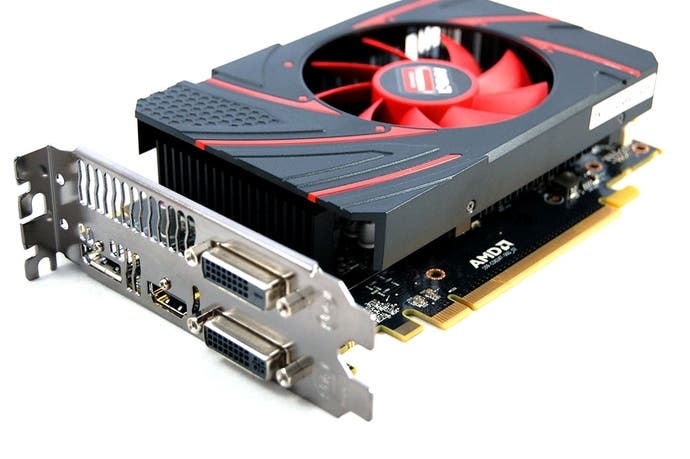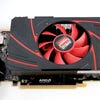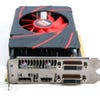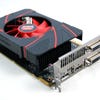Can a £100 PC graphics card match next-gen console?
Launch title performance stacked up against the Radeon R7 260X with some surprising results.
Released just a month before the Xbox One and PS4 hit UK retail, the Radeon R7 260X is a value-focused graphics card that brings stiff competition to both next-gen platforms. In essence, we're promised a card that can deliver true, next-gen calibre results at under a third of the cost of a new console - the price-tag being just south of £100 at the time of writing. But just how does such a card stack up to the console experience when playing Battlefield 4 or Assassin's Creed 4: Black Flag? And indeed, can we go one further in the visual stakes - while still hitting the same performance targets?
First things first, let's address a few salient points on the card itself. The 260X is a through-and-through rebrand of the Radeon HD 7790 we reviewed last year, complete with the very same 28nm processed Bonaire XT chipset (in itself, the basis for the Xbox One GPU) - but now with minor clock tweaks and a cheaper price-tag. The changes are easy to list: we get a core clock bump of 10 per cent, going from 1GHz to 1.1GHz. Otherwise, the restrictive 128-bit memory bus remains, but the memory speed increase to 6.5GHz (compared to 6GHz on the 7790) means a fill-rate of 102.4GB/s is now possible - a respectable update over the 96GB/s of the last card.
In terms of features, this refresh gets all the potential benefits of AMD's as-yet untested Mantle interface (an alternative to DirectX that's soon to be supported by Battlefield 4). As a bonus, the 260X also comes with a dedicated TrueAudio sound processing unit, absent from its pricier 270X and 280X siblings. This works entirely independently of graphical tasks, allowing developers to add spatialisation, reverb and a mastering of sound not possible on most users' motherboard sound.
The cheeky twist is that, while these sound processing tricks are new to the 260X, the on-board chip has in fact been present and inactive all this time on the 7790's PCB - a card that released almost a year ago. But we won't dwell on that...
Physically we're looking at a stubby, dual-slot card measuring at 17.5cm, which means it only needs coverage from a single fan to the front of an open-case cooler. Power requirements are also meagre and should fit anyone's bill; it takes a single 6-pin PCIe connector, where the peak draw is rated at 115W (up from 85W on the lower-clocked 7790). On the connectivity side we have every flavour of output you could hope for: one DVI-D, a DVI-I, a single HDMI out, plus a DisplayPort connection. Between these options, a display resolution of up to 4K is possible - but the R7 prefix should tell you that 1080p is really the intended maximum for this card.
Low energy demands bode well for noise and thermals of course, and the 260X doesn't disappoint. Unsurprisingly for a GPU that steers clear of the breakneck clock speeds seen in AMD's top-end 290X, the card is inscrutably quiet at even peak operation, and also relatively cool. The sensors read out 26 degrees Celsius while idle on desktop, for example, while the peak temperature during our looped Metro Last Light benchmark tests is 80 degrees. Not bad at all, and a healthy result that puts it in good stead for comparison with the next-gen console GPUs.
Price-wise, it's easy to find 1GB versions of the R7 260X under £100 (and 1GB Radeon HD 7790s now appear to be entering end-of-line status, often selling at the £80 mark) but our test unit is a beefier 2GB reference card, which does tend to command a small price premium. However, at the time of writing, a 2GB Sapphire R7 260X model is available at our £100 target price at UK retailer, Ebuyer.
On to the tests, and Battlefield 4 is our very first stop when putting the 260X through its paces. Installed in a PC featuring an Intel i7-3770k processor clocked at 4.3GHz per core, and 16GB of DDR3 RAM, most bottlenecks are removed here when running the Frostbite 3 engine. This should, in theory, give us a clear picture of what this card can pull off.
We run Battlefield 4 on high settings to get the most direct comparison with the console releases. This preset gives us the same horizon-based ambient occlusion (HBAO) as seen on Xbox One and PS4, plus a match for their normal map quality, shadows, and a similar grade of post-process AA. From here, we run the game at 1280x720 (the Xbox One version's native resolution) side-by-side with 1600x900 (PlayStation 4), and another matching playthrough at a full 1920x1080.
"720p. vs. 900p vs. 1080p Battlefield 4 testing reveals that full HD is too much of a stretch, but overall results reveal the R7 260X offering an experience very close to the PS4 version of DICE's tech tour-de-force."
The turn-out is par for course given the card's restrictive 104GB/s fill-rate. In the end, 900p is the best immediate fit for the card, where the frame-rate sticks to 60fps during most of the typical run-and-gunning - with expected drops for set-pieces on the Baku stage. Playing at 1080p is just too much of a stretch at this high setting, with regular dips to 45fps cutting it short of a smooth experience at every turn. That said, by ratcheting lighting and post-process effects down to medium we reclaim a reasonably solid 60fps for this resolution. It's a worthwhile workaround, since the downgrade in these areas isn't always readily apparent. However it isn't quite as smooth as opting for a lower resolution entirely.
With this in mind, we have the GPU running Battlefield 4 at 900p - to match the PS4 release - in a direct comparison with both next-gen console versions. Graphics settings are once again left on high with v-sync engaged, and the results are striking. For dense forested areas, the PS4 does take a marginal lead, whereas the 260X lurks at 55fps and Xbox One version trails at 50fps. This all changes during battle though, where we see the £100 GPU trumping both next-gen versions during heavy open-ended gameplay culminating in a giant explosion. This brings both consoles far below the 60fps line, while the 260X only drops a few frames.
This rate doesn't necessarily hold up during one cut-scene involving a crumbling building, for which the 260X dips below Sony's hardware at 40fps. However, this is an unusually effects-heavy sequence in the grand scheme of the campaign mode, where the general flow of play is on average closer to the 60fps line. It's also noticed that running on high settings gives us superior LOD draw for small objects than is possible on PS4 - and at no real performance penalty.
Less remarkable is performance in Need for Speed: Rivals. We elect to run at full 1080p this time to match both console releases, and with lighting, reflection and effects quality pegged at ultra, plus HBAO. The only snag here is that, much like the PS4 and Xbox One versions, the PC build is locked at 30fps by default. On the plus side there isn't a single dip below this figure even with the game completely maxed out, giving us a monotone reading.
"Across four multi-platform titles, the R7 260X holds up very close against Xbox One and PS4 - even improving in some areas, faltering only on Call of Duty: Ghosts."
However, with Rivals' cap we have no perspective of just how much of an overhead the game is running with. To unlock the frame-rate, at risk of meddling with the game's physics engine, we enter "-GameTime.MaxSimFps 60 -GameTime.ForceSimRate 60.0" into the title's properties box. With the game on its highest setting, it turns out 45fps is the rate we're looking at when unbounded, while dropping to low settings gets us in the region of 55-60. However, the severe drops to the 40s while in busier town areas shows the 260X just isn't suited for this target frame-rate at 1080p.
It's a similar story for Assassin's Creed 4: Black Flag, with its own notorious 30fps cap keeping our results in sync with the PS4 and Xbox One versions. Here we have environment, textures, shadows and reflection settings on high, with SMAA to match post-processing on consoles, and also SSAO. Pushing god rays above the low quality setting causes regular dips to 20fps - and likewise for a bump to HBAO+ - meaning we steer clear of both to achieve a predominately 30fps refresh. At 1080p there are only occasional dips during naval warfare, but running around Abstergo Industries and the Caribbean cities goes without a single hiccup. Success!
The last of the sequence is Call of Duty: Ghosts. This is the one which gives us the most grief when tweaking settings for the 260X; partly due to the game cutting to a tedious loading screen after every tiny change, and partly because it appears to be woefully under-optimised for PC. By comparison, the PS4 and Xbox One releases use low resolution shadow filtering, post-processing AA, SSAO rather than HBAO+ available on PC, plus pared-back alpha effects.
For the 260X, Ghosts defaults to low settings across the board, which isn't an encouraging start. To hit 60fps while matching the PS4's level of visuals, we push for full 1080p, with terrain detail and texture mapping at high. This sounds excessive, but it turns out that anything less gives us muddy, low resolution textures that fall far below next-gen console standards. We also enable 1x SMAA, and high ambient occlusion, but make sure dynamic fur is disabled to avoid sharp drops to 20fps.
"CPU choice should also be factored into the console comparison. Our standard GPU test-bed features an overclocked Intel i7 but we achieved comparable results with a much cheaper hex-core AMD FX-6300."
But all of this only considers the 260X as a solo purchase, when in fact the cost of the CPU has an impact on some results. The quad-core Intel i7-3770K used in each of these tests will set you back by £240, for example, which begs the question: just how integral is this part in bringing out the best in the GPU? To investigate, we plant the 260X into another PC built from AMD parts, this time containing a hex-core FX-6300 CPU (£85 as of writing), plus a more typical allocation of 8GB DDR3 system RAM.
And there are differences, if not vast in scale. While Need for Speed Rivals and Assassin's Creed 4 stay firmly locked to the 30fps line, as before, Battlefield 4 is a trickier customer. The Frostbite 3 engine is known for deferring tasks across multiple cores, and in this case we see physics and alpha effects dragging the frame-rate down to 52fps during a big explosion on the Baku stage - giving a 13 per cent lead to the Intel chip at 60fps. This is running the game on high settings at 900p, but fortunately, regular play on the AMD chip unfolds at much the same 60fps rate. We should also point out that the tests were run on Windows 7, where an upgrade to the latter Microsoft operating system should improve results still further.
Pairing the 260X with AMD's FX-6300 CPU has little impact on Call of Duty Ghosts either, save for a longer drop to the 30fps line as we drive across a battle-strewn stadium. This counts as an eight per cent advantage to the i7-3770K which runs at closer to 35fps during this sequence. However, gameplay on both CPUs fluctuates around the 40-50fps no man's land when in a typical corridor shoot-out scenario, meaning neither can really match up to the fluidity being achieved on consoles.
"With careful settings management, this £100 graphics card can still produce a playable, visually pleasing experience on a truly demanding piece of software like Crysis 3."
The game's "image quality" selector is also a real danger area for this budget card. This essentially changes the internal resolution and scales up to our selected 1080p output. It also takes a huge toll on the 260X, meaning we're dealt a rock and a hard place situation; either the game appears too soft, or it plays out in a sluggish manner. It's only on normal image quality that we can nail a perfect 60fps, but in order to achieve true parity with the PS4's native 1080p we simply have to select the extra setting for an authentic full HD image. It's a force of hand that means the 260X can only run Ghosts within the 30-50fps range.
Incidentally, switching to 1280x720 resolution - to match the native frame-buffer on Xbox One - helps in this regard. Alas, this still doesn't give us the reliable controller feedback a twitch shooter deserves, with 50-60fps being the rough target during the Struck Down stage. Stuttering drops are possible here too, easily noticed when entering the stadium area for an on-rails shoot-out. All in all, this is the only game to show up the 260X in its bid to match the PS4 and Xbox One versions.
Not covered in our cross-platform tests is Crysis 3. Here we try something a bit different to stretch the card on its own terms, by comparing the medium setting results with a separate playthrough on high. Neither truly gets close to a perfectly stable 60Hz refresh, but with a 30fps cap the 260X is at least able to play the game at 1080p without any issues. Again, we see huge performance gains from opting to drop the resolution to 1600x900 and lower here - and again relying on post-process solutions for AA.
Moving onto our GPU benchmark runs, we discover some interesting findings: the clock-speed improvements over the preceding HD 7790 are noticeable, but there's a clear gap between the R7 260X and the outgoing Radeon HD 7850 - still a remarkably decent card, and often available in the £100 range if you can find an online store clearing stock. Some of the more strenuous benchmark tests are revealing of the 260X's limited bandwidth fill-rate, so here we've benched at quality settings typically one step down from the max, with multi-sampling AA kept to the minimum. While there are clear compromises at these reduced settings, overall image quality is still a relatively good match - by necessity, all PC games are built with scalability in mind and it's good to see that even a budget card can still hand in a decent experience, even on some pretty demanding software. A bit of thought in settings management is essential with cards like this: in this video you can see a re-run of our benchmark runs, this time with quality levels ramped up to the max - and let's just say that the performance level is not a pretty sight.
"Typically speaking, moving one notch down from max settings and reducing expensive anti-aliasing options produces good results at 1080p."
| 1920x1080 'Value' | R7 260X 2GB | HD 7790 1GB | HD 7850 1GB | GTX 650 Ti Boost 2GB |
|---|---|---|---|---|
| BioShock Infinite, Very High | 57.3fps | 54.4fps | 66.9fps | 64.1fps |
| Tomb Raider, High, FXAA | 61.1fps | 58.5fps | 77.8fps | 78.2fps |
| Metro 2033, High, AAA | 29.5fps | 27.0fps | 40.0fps | 36.9fps |
| Metro: Last Light, High | 34.0fps | 31.6fps | 38.6fps | 36.8fps |
| Hitman: Absolution, High, 2x MSAA | 36.9fps | 35.2fps | 45.0fps | 39.8fps |
| Sleeping Dogs, Extreme | 47.9fps | 45.2fps | 54.5fps | 54.0fps |
Radeon R7 260X vs. next-gen console: the Digital Foundry verdict
Even on the most modest of budgets, AMD's £100 card is nicely poised as a match for the PS4 and Xbox One's graphical horsepower, based on the performance of the launch titles at least. Clearly the consoles have more to give - especially in exclusive titles - and we wouldn't be surprised at all to see the gap widen over time, particularly as the R7 260X clearly faces some bandwidth problems owing to its 128-bit bus.
"In three out of four tests, the R7 260X matched next-gen console, but we can't help but feel that spending just a little more on your GPU will provide more long-term value."
But in the here and now, for those with PC setups long overdue for an upgrade, the Radeon R7 260X could be seen as an economical alternative to buying a next-gen console. Visual quality in games like Assassin's Creed 4 and Battlefield 4 runs at a flat high setting with this GPU at no performance penalty, while console editions rely on curtailed LODs, and lowered texture filtering settings. We couldn't help but expect more from the new platforms - especially from PS4, where the GPU architecture offers a range of advantages over the Bonaire core at the heart of the R7 260X (though to be fair, at 1.9TF, the R7 260X marginally out-scores PS4's overall compute power).
That said, for all the advantages we found in our tests, we do notice a worrying trend in this recent slate of PC releases. Need for Speed: Rivals is capped to a console-standard 30fps, while Assassin's Creed 4 requires a lot of GPU horsepower to sustain 60fps, dropping down hard to 30fps on less capable hardware. Likewise, the PC version of Call of Duty: Ghosts is in a bit of a state, which despite several attempts to achieve parity with the console settings, was held back, seemingly due to poor optimisation. Bearing in mind the many commonalities between console and PC development, we were surprised at just how poorly the new Infinity Ward game ran on our computer, especially in comparison to the technologically more ambitious Battlefield 4.
But overall, our testing gave encouraging results for PC gamers. If £100 is the minimum expense for next-gen console performance in a GPU, there are few wrong turns when shopping for a card above that price bracket. In fact, for a more future-proof option, we'd urge you to consider the R9 270 - it's available for around £30 more, and provides a number of advantages, including more memory bandwidth via a 256-bit bus, plus the same GPU architecture as PlayStation 4 but with more available compute units and a higher clock-speed. Additionally, it should overclock easily enough to match the more expensive Radeon R9 270X. Alternatively, keep your eyes peeled for end-of-line Radeon HD 7850s, available frequently at around £100, which again offer a handsome performance bump over the R7 260X.




















